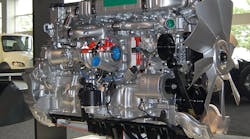DETROIT.Detroit officials hosted a media event this week at its 3.2-million-sq.-ft. facility in Detroit, outlining the company’s path to greenhouse gas 2014 (GHG14) engine compliance and changes made to the new DD15 engine that will be the primary powerplant for Daimler Trucks North America’s (DTNA) Freightliner Cascadia Evolution tractor.
DTNA was the first manufacturer to have its vehicles certified to meet GHG14 regulations set forth by the Environmental Protection Agency and the National Highway Traffic Safety Administration.
“It is our goal to pace the industry in emissions compliance and fuel efficiency. Early submissions for GHG14 engine compliance is evidence of this strategy for the updated family of Detroit engines,” said Brad Williamson, manager, engine and component marketing for Daimler Trucks North America. “The Detroit brand is synonymous with power and efficiency, and our enhanced engine lineup builds on our tradition of providing our customers with the best performing products in the market today while meeting the emissions regulations.”
The big change in the 2013 line is the DD15. The new DD15 will be exclusively matched to the new Cascadia Evolution tractor that sister company Freightliner took the wraps off at the Mid-America Trucking Show in March. Both companies are part of Daimler Trucks North America (DTNA).
By being able to offer an integrated package between the Evolution, which has shown in testing to provide up to a 7% improvement over a first-generation 2010-compliant Cascadia, the new DD15 engine, proprietary axles and even a new DT12 transmission, DTNA is able to provide customers with a finished product that maximizes fuel efficiency, serviceability, and customer satisfaction, Detroit officials said.
The new DD15 has seen a number of updates from the old DD15, which has been renamed the DD15 TC and will still be produced for those fleets that want a 15L engine. The engine features an asymmetric turbocharger with a next-generation amplified common rail system for improved performance and fuel economy.
“We’ve tuned this [package] to be optimum for the fleet operation that is the most common for the Cascadia in North America,” said Mark Groeneweg, director of Daimler Trucks powertrain engineering-NAFTA.
The company also switched from a twin filter system to an improved single filter system that doubles filter change intervals to 100,000 mi. on most engines.
“We’ve run these in our reliability productivity fleet in Oregon and 100,000 mi. is a conservative estimate,” Groeneweg said.
The new filter system also requires less priming strokes and offers easier access to the water drain, the company added.
A new variable speed water pump that is electronically controlled allows the system to pump coolant only when it is needed, further improving fuel economy.
Additional engine enhancements include an optimized piston design, which reduces oil consumption through the use of an improved oil control ring; and ACRS, which provides higher injector pressure for improved combustion control while eliminating the pressure regulator, improving overall engine performance.
The DD15 engine overall weighs 100 lbs. less than the DD15 TC.
All of the 2013 engines in the lineup – the DD15, DD15 TC, DD16, and DD13 - have received a new 1-Box system as part of an upgraded BlueTec emissions system. The new 1-Box includes fewer parts and has been universally configured for all trucks, which also speeds serviceability, Detroit said.
The big change in the BlueTec system is the elimination of the air-assisted technology used to inject diesel exhaust fluid into the exhaust in favor of a liquid-only delivery system. According to Groeneweg, this will also contribute to improved fuel economy.
The DDEC electronics architecture also been tweaked. “We’ve reworked our electronics architecture to increase speed,” Groeneweg pointed out. “We’ve updated the processors and also [designed it] to accept the Detroit transmission.”
The DD15 TC is the “original” DD15, if you will. “Today’s DD15 is tomorrow’s DD15 TC,” said Williamson. “There is a lot of reasons for that, but the main one is we wanted to give the customer [options].”
Since the new DD15 will only be available in the Cascadia Evolution at this point, both Freightliner and Western Star customers looking for a 15L would have been left without a Detroit engine choice. The DD15 TC (which stands for turbo compounding) will receive many of the engine family changes including the new DDEC electronic controls and improved fuel filter system, Detroit said, and ensure customers still have options.
The DD16 has been tweaked as well, notably a new power range. The engine will now offer horsepower ranging from 505 to 600 with up to 2,050 lbs.-ft. of torque.
The DD13 also includes fuel injector nozzle modifications and a new crankcase sensor for OBD requirements as well as the aforementioned engine family changes. With ratings from 370-470 hp. and a torque range from 1,250 to 1,650 lbs.-ft., the engine remains an excellent choice for regional, less-than-truckload, and vocational applications, according to the company.



